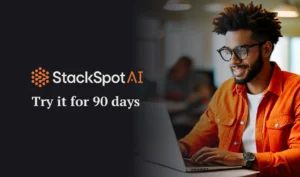Note: This blog post was created by the StackSpot Prompt Engineering team with the support of AI tools. This content underwent rigorous review for technical accuracy, content relevance, and well-written quality before its publication. Enjoy the read!
Generative AI tools are transforming how software engineers write code. These powerful AI assistants can help programmers boost productivity, improve code quality, and future-proof their skills. In this post, we’ll explore 10 tips software engineers can use to code with generative AI, faster and better.
1 – Focus on the problem, not the solution
When using generative AI to write code, focus on clearly explaining the problem you want to solve, not how you would solve it. Describe the program’s desired functionality in plain English. Let the AI generate the actual code. This allows the AI to come up with creative solutions you may not have considered.
2 – Provide examples and constraints
Give the AI examples of similar programs and code snippets to guide its output. Specify any constraints like coding languages, frameworks, performance requirements, or security needs. This context helps the AI generate relevant, effective code.
3 – Iterate quickly
View the AI’s initial code output as a starting point, not the final product. Refine the prompts and iterate quickly to improve the results. Tweak the problem statement, provide new examples, and give feedback on what works and what doesn’t. With each iteration, the code will get better.
4 – Supplement, don’t replace your skills
Use generative AI as a tool to supplement your existing skills, not replace them entirely. Review the AI’s code carefully, fill in gaps, optimize where needed, and verify logic, efficiency, and security. Think of the AI as a coding assistant, not the sole programmer.
5 – Understand the limitations
While powerful, AI has limitations. It may struggle with complex logic, exceptions, mission-critical systems, and innovative algorithms. Provide sufficient context and examples to get the best results. Be ready to override incorrect or dangerous code the AI may generate in edge cases.
6 – Generate code snippets, not entire programs
Rather than having the AI generate entire programs, use it for shorter code snippets that you can integrate into your larger codebase. This allows for more control, makes reviewing and optimizing the code easier, and prevents mistakes at scale.
7 – Augment your testing
Use generative AI to create test inputs and scenarios to cover edge cases. The AI can come up with tests you might not have thought of on your own, improving your test coverage. Review the tests thoroughly and extend them as needed for your specific use case.
8 – Stay up-to-date
Like any tool, you need to stay current as generative AI and its applications evolve. Monitor advances in AI functionality, new platforms, and ethical considerations. Continue honing your skills to use these technologies most effectively over time.
9 – Mitigate bias in the AI
When using any AI, be aware it may inherit and amplify societal biases in its training data. Review the code thoroughly to catch any biased logic or exclusions. Consider techniques like auditing data sources and fine-tuning diverse data to mitigate bias issues.
10 – Align on ethics
Discuss and align ethics policies for the use of generative AI across your teams. Establish guidelines to prevent misuse and ensure coding best practices are followed when using AI. Keep ethics in mind when applying AI to create safe, inclusive products.
Conclusion
Generative AI presents exciting opportunities for software engineers to become more productive and creative coders. Follow these tips to integrate AI effectively into your coding workflows, augment your skills, and future-proof your career in this rapidly evolving field. With the right strategy, generative AI can help every engineer code faster and better.
Leave a comment on this article about “10 tips for software engineers to code with Generative AI, faster and better” and check out our blog for more content!
Meet the Enterprise Coding Assistant – StackSpot AI
Do you struggle to follow your organization’s coding guidelines and best practices? Say hello to StackSpot AI, the enterprise-focused coding assistant.
StackSpot AI taps into your company’s context – from style guides to custom logic – to generate compliant code automatically. Just describe what you want to build in plain English, and it will suggest secure, reliable code that aligns with standards.
With StackSpot AI, you get all the productivity benefits of AI-generated coding tailored to your business needs. No more discovering code debt during reviews!
Ready to code faster while adhering to enterprise policies? Sign up now for early access to Context-Aware from StackSpot AI. Step into the future of compliant coding with your new AI pair programmer. Enter the waitlist for StackSpot AI!






